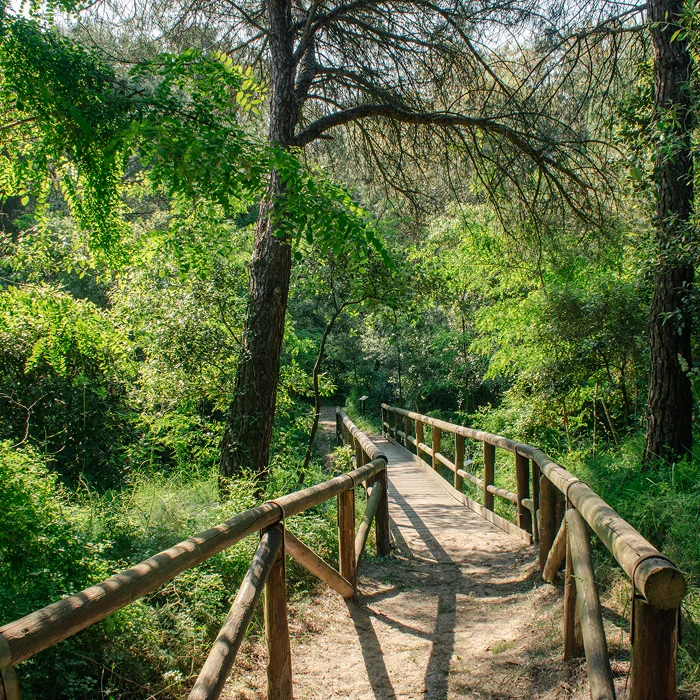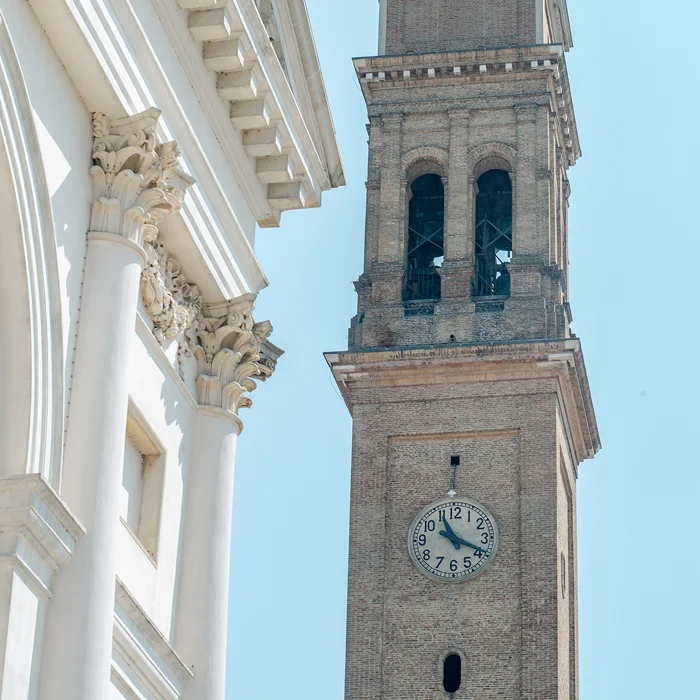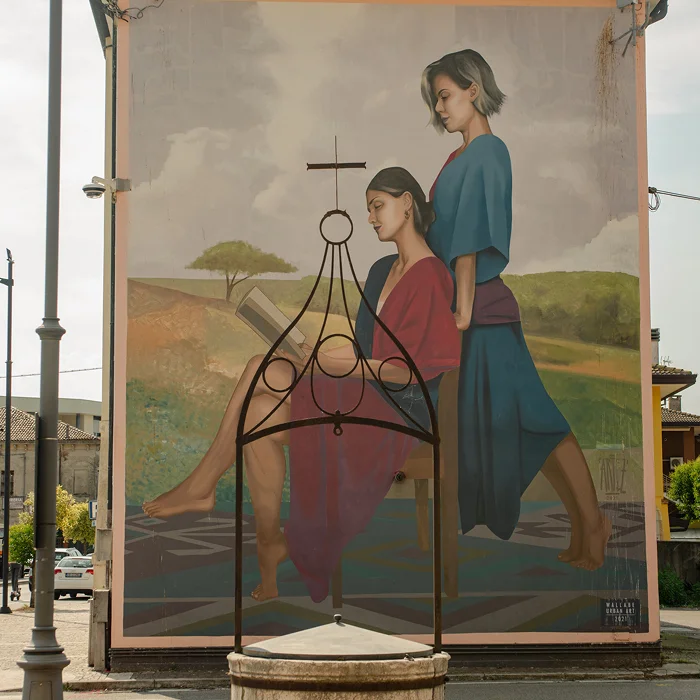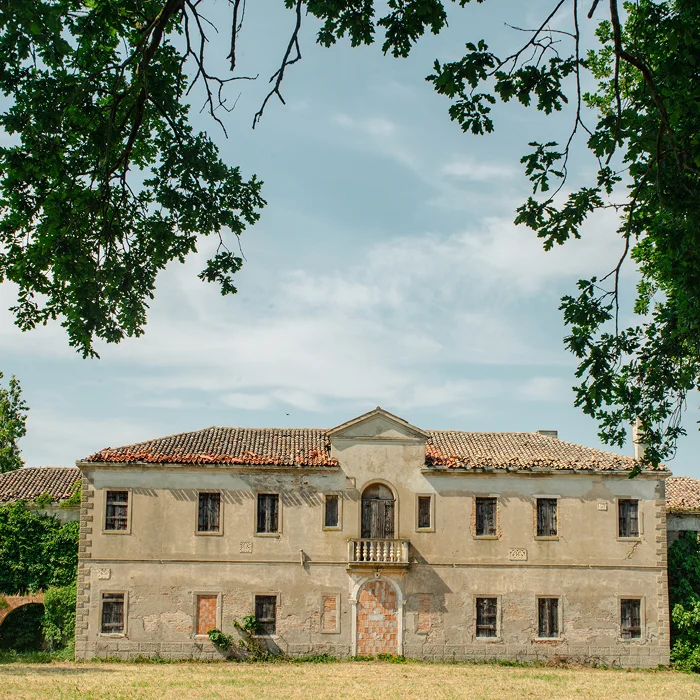This is an experience to enjoy like an immersion because in different areas of Porto Viro you move under the sea level! Welcome to a surprising five-stop itinerary in places where history is primarily made by man’s work on nature, and not everything is as simple and slow as it seems at first sight. On these quiet roads, the roar of an Alfa Romeo 20-30 ES, a car also driven by Enzo Ferrari, warned of the passage of Baroness Maria Antonietta Avanzo, née Bellan, an icon of women’s emancipation, Italy’s first female pilot. She’s the pride of an entire community, as since 1995 Donada and Contarina have been united into a reality called Porto Viro, according to the will expressed by the population in a special referendum. In Piazza Matteotti, a mural depicts Donada and Contarina as two women in front of the same book, united in a single gaze. Porto Viro is the heart of the Po Delta, where “the land does not begin and the sea does not end,” confirming that behind an apparent simplicity, these places encompass an alluring complexity where you can delve in.
A dive into the green
To the north of the urban center extends the Fornaci Pine Forest, the largest green lung of Porto Viro, characterized by fossil dunes, i.e. sandy formations shaped by the action of the wind near ancient coastline lines. They are defined as “fossils” because they are no longer influenced by aeolian and marine processes. Their presence proves that the coastline has advanced significantly eastwards due to the accumulation of river sediments from the Po. The maritime and domestic pines that make up the majority of the pine forest have been planted since the early twentieth century and especially in the 40s and 50s. In recent years there has been spontaneous thinning of pines which has allowed native plants, such as holm oak and downy oak, to stand out.
This is an important biodiversity area, so much so that it has been classified as a Site of Community Importance (SCI), which is part of the Natura 2000 Network, an ecological system of protected areas established by the European Union to ensure the long-term maintenance of natural habitats and threatened or rare species of flora and fauna. Over time there has been a progressive thinning of the pines which has given way to native elements such as oak, holm oak and downy oak. Plants and shrubs, typical of the dunes are: butcher’s broom, hawthorn, white hornbeam, pungent asparagus, laurel, field elm, frangola, negundo maple and lantana. Among the flowers, the most valuable are some types of orchids and Centaurea tommasinii. As for the fauna, you can admire various mammals, reptiles, amphibians and birds. In particular, you can come across foxes, hares, hedgehogs, martens, weasels, squirrels, moles and bats. Among the birds that nest here, there are great spotted woodpeckers, orioles, bee-eaters, hoopoes, jays, cuckoos, wild doves, owls, wood pigeons, nightjars and owls.

Monumental Porto Viro
At 63 metres high, the imposing bell tower adjacent to the church of the Visitation of Mary is the tallest in eastern Polesine. The original was from the 19th century, struck by lightning in 1922, and was rebuilt in 1927 with a shape reminiscent of Saint Mark in Venice. The oldest church in Porto Viro is that of San Bartolomeo in Piazza Matteotti, built starting in 1726, enriched in 1787 with the installation of an organ by Gaetano Callido. Also noteworthy is the marble baptismal font (sec. XVIII) and the wooden statue of the Patron Saint (sec. XVII) in niche.
The frescoes on the ceiling vault date back to 1829 (Birth and Martyrdom of St. Bartholomew with monochrome figures and Glory of St. Bartholomew in polychromy).
A few steps from the church, you can admire Villa Contarini-Carrer, the oldest in Porto Viro, built in the 17th century by the noble Venetian Contarini family. They were also responsible for the construction of the first church of Contarina, dating back to the 16th century and devastated at the beginning of the following century by a flood of the Po. In its place, the current church of San Bartolomeo was built in neoclassical style. Also worth a visit is the former slaughterhouse in Via Navi Romane, dating back to the early twentieth century and now home to the municipal library

Donada e Contarina
With the advent of the Venice Republic, in the 12th century, Donada and Contarina were born, whose names are taken from the surnames of the Venetian nobles Donà and Contarini, concessionaires of lands from being restored. With the Royal Decree in 1928 the two realities were united to create the municipality of “Taglio di Porto Viro”. The new municipality took the name of “Porto Viro” in 1932. The most evident testimony of the period is the town hall built in what is now Piazza della Repubblica. In 1938, however, the young municipality was dissolved for political reasons. With the consultative referendum of 12 June 1994, the popular desire to see Donada and Contarina united in a single municipality called Porto Viro was finally realized.
That day over 80% of voters voted in favor of the merger, which was later sanctioned by the Regional law N. 49 of 14 September 1994 and its application from 1° January 1995. Tradition has it that behind the 1928 union there was the hand of an important local figure, Admiral Luigi Arcangeli, who would have imagined a large urban center in the heart of the Delta. Since 12 November 2001, thanks to the decree of the President of the Republic Carlo Azeglio Ciampi, Porto Viro received the title of “City”, a recognition for a community that even overcame the devastating flood of 1951 and today is the third municipality in the province of Rovigo by population. This square,dedicated to those who fell for the freedom of Trieste, testifies to the solidarity demonstrated at the time by the city of Trieste in the reconstruction of Donada and Contarina. The “Villaggio San Giusto” was built in this area and the small church on the eastern part of the square and the pine forest to the west are dedicated to the patron saint of Trieste.

The cut that makes the history of the Po Delta
Between 1600 and 1604 the Republic of Venice carried out a large hydraulic work for divert the main course of the Po further south away from the Venice Lagoon and thus avoid siltation caused by river sediments. The project, known as “Taglio di Porto Viro” involves the excavation of a new artificial riverbed of approximately 7 kilometers to bring the water of the great river from Cavanella Po (Port of Loreo) towards the Sacca di Goro. They are composed of new lands reclaimed from the sea, which, once reclaimed, become valuable for agriculture, in particular cereal cultivation. Fishing valleys, natural oases and schools are also formed and the bonnelli and all our wonderful Po Delta.
The new hydrographic structure also influences the lagoons and fishing valleys, with the creation of new transition areas between fresh and brackish water, essential for fish farming. Coming to be found on the main branch of the Po, the river landing to places of Donada and Contarina takes on strategic importance for transport and the two centers record a notable demographic increase. In Piazza Matteotti, the municipality of Porto Viro hosts the Visitor Center of the Po Delta Regional Natural Park, an ideal place for those who want to delve deeper into the evolution of this area, in particular through a huge diorama that reproduces the delta.

The Flying Baroness
Maria Antonietta Avanzo, born Bellan in 1889, is certainly the most important personality born and raised in this area, the first woman to partake in car races, to compete in a strictly male environment. The childhood home is located in Villaregia (now abandoned). Her determination was revealed as a young girl, when she took the liberty of getting into her father’s car and roaming the streets of the town alone. The parent didn’t hinder her. After her marriage to Baron Eustachio Avanzo she was nicknamed “Baroness” and moved to Rome. As a gesture of support for her love of driving, her husband gave her a Spa 35/50 Sport, a car with which she ran her first race, the Giro del Lazio, in 1920.
Marie Antoinette’s skill behind the wheel was cutting edge, so much so that the female driver was the victim of numerous episodes of sabotage against her cars. Among the alleged saboteurs, the most illustrious would be Enzo Ferrari, a driver and teammate of the Baroness at the time. What is certain is that the future founder of the “Cavallino rampante” also publicly recognized the skill of the Avanzo behind the wheel. In fact, Marie Antoinette challenged the champions of the time and in 1921 gave the rising star Tazio Nuvolari a hard time on the Garda Circuit, placing third. On that occasion he met Gabriele D’Annunzio, with whom he began a long correspondence. The poet nicknamed her “Nerissa”, for those dark eyes and hair. In 1928 she took part in the Mille Miglia driving a Chrysler 70. She ended his career with a sixth place at the 1939 Tobruk-Tripoli, at the wheel of a Fiat 1100 MM. She died in 1977 in Rome.

Start the tour
Check the map, reach the first stop and start the route.
Point of interests
- A dive into the green: at the intersection between Via Mantovana and Via Cao Marina (southern entrance to the Fornaci pine forest)
- Monumental Porto Viro: Marconi Square in Donada
- Donada and Contarina: Caduti Triestini square (via Mazzini)
- The cut that makes the history fo the Po delta: along the Po river
- The Flying Baroness: baroness house
PROGETTO FINANZIATO CON IL PR VENETO FESR 2021-2027
Pagina aggiornata il 05/08/2025
